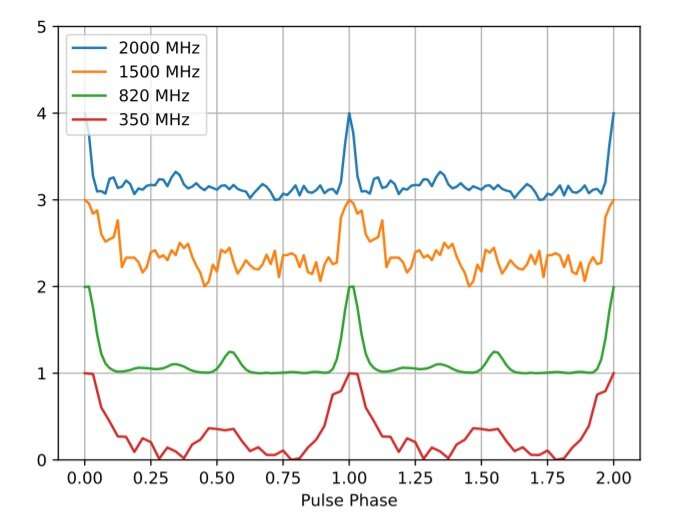February 17, 2022 report
New 'black widow' millisecond pulsar discovered

An international team of astronomers reports the detection of a new millisecond pulsar (MSP) using the Green Bank Telescope (GBT). The newfound pulsar, designated PSR J1555−2908, turns out to be one of the so-called "black widow" MSPs. The finding is detailed in a paper published February 10 on arXiv.org.
The most rapidly rotating pulsars, those with rotation periods below 30 milliseconds, are known as MSPs. Researchers assume that they are formed in binary systems when the initially more massive component turns into a neutron star that is then spun up due to accretion of matter from the secondary star.
A class of extreme binary pulsars with semi-degenerate companion stars is dubbed "spider pulsars." These objects are further categorized as "black widows" if the companion has extremely low mass (less than 0.1 solar masses), while they are called "redbacks" if the secondary star is heavier.
PSR J1555−2908 was initially identified as a gamma-ray point source by NASA's Fermi spacecraft. Given that a large number of point sources in the GeV gamma-ray sky are known to be powered by pulsars, PSR J1555−2908 was perceived as a promising target to search for pulsations. Therefore, a team of astronomers led by Paul S. Ray of the U.S. Naval Research Laboratory in Washington, DC, has investigated this source with GBT, which resulted in the detection of radio pulsations.
"This fast and energetic millisecond pulsar was first detected as a gamma-ray point source in Fermi Large Area Telescope (LAT) sky survey observations. Guided by a steep spectrum radio point source in the Fermi error region, we performed a search at 820 MHz with the Green Bank Telescope that first discovered the pulsations," the researchers explained.
GBT observations identified radio pulsations of PSR J1555−2908 with a 1.79 ms period. Afterward a 5-minute GBT observation at S-band confirmed the discovery and determined the pulse width at 559.4 Hz to be very narrow—about 3%. By analyzing the Fermi data, gamma-ray pulsations have been also detected from this source.
According to the study, PSR J1555−2908 is an interacting binary system with an orbital period of approximately 0.23 days. The neutron star's mass is estimated to be some 1.4 solar masses, while the minimum mass of the companion star was calculated to be about 0.052 solar masses. These results indicate the "black widow" class of this MSP.
PSR J1555−2908 has a relatively high spin-down power—at a level of 310 decillion erg/s. Such a high value makes it a good candidate to search for X-ray pulsations, as other MSPs with comparable spin-down power are known to exhibit bright non-thermal pulsations. However, the team analyzed the available data from the Neutron Star Interior Composition ExploreR (NICER) but, so far, has not found any significant X-ray pulsations from this pulsar. This may change as the researchers continue their monitoring of PSR J1555−2908 using ground-based facilities.
More information: Discovery, Timing, and Multiwavelength Observations of the Black Widow Millisecond Pulsar PSR J1555−2908, arXiv:2202.04783 [astro-ph.HE] arxiv.org/abs/2202.04783
© 2022 Science X Network




















